One of the best parts of camping is cooking over a campfire. The aroma of roasted marshmallows, sizzling sausages, and delicious, crispy bacon helps us enjoy the great outdoors to the fullest.
Whether it is to get your day started with a power breakfast, or after returning from a long day of adventure to whip up a delicious dinner under the stars, you need a well-prepared campfire cooking kit that is simple, flexible and efficient.
If you don’t have a backpacking stove and you’ve ever struggled with a makeshift setup, burnt food, or forgotten essentials, this checklist is your ticket to cooking success in the wild.
Let’s dive into the ultimate guide for assembling the best campfire cooking kit that will have you cooking like a pro on your next adventure.
Note: don’t miss the downloadable ultimate checklist at the end!
Essentials of a Campfire Cooking Kit
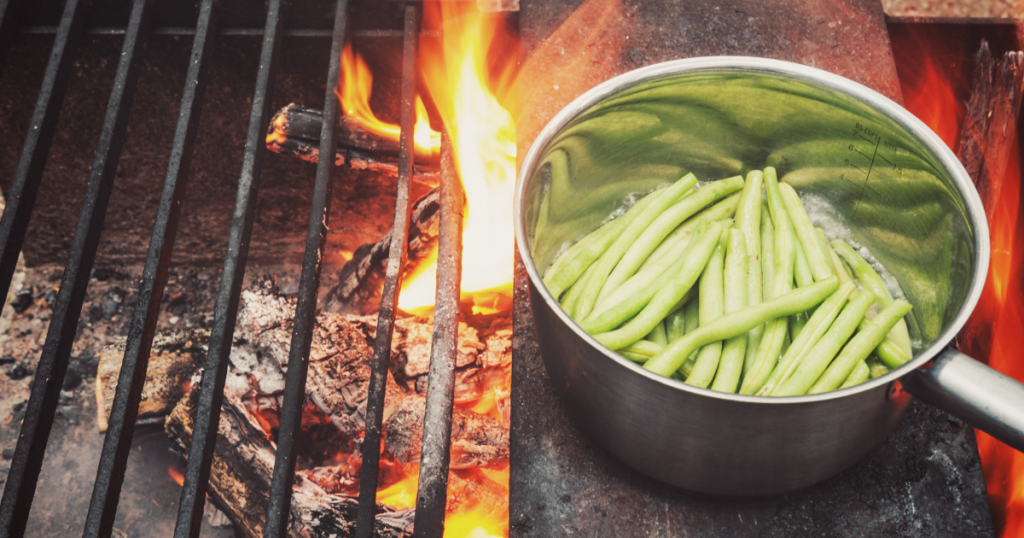
The type of cookware you use can greatly affect your campfire cooking experience. Here are some recommended materials suitable for campfires:
- Cast Iron: Best for heat retention and durability. Requires seasoning to maintain its non-stick surface. Very heavy and should be avoided by anyone looking to stay on the go.
- Stainless Steel: Lightweight, corrosion-resistant, and ideal for boiling or steaming.
- Aluminum: Lightweight and affordable but less durable.
- Titanium: Extremely lightweight and strong, but more expensive than other materials.
Must-Have Tools and Utensils
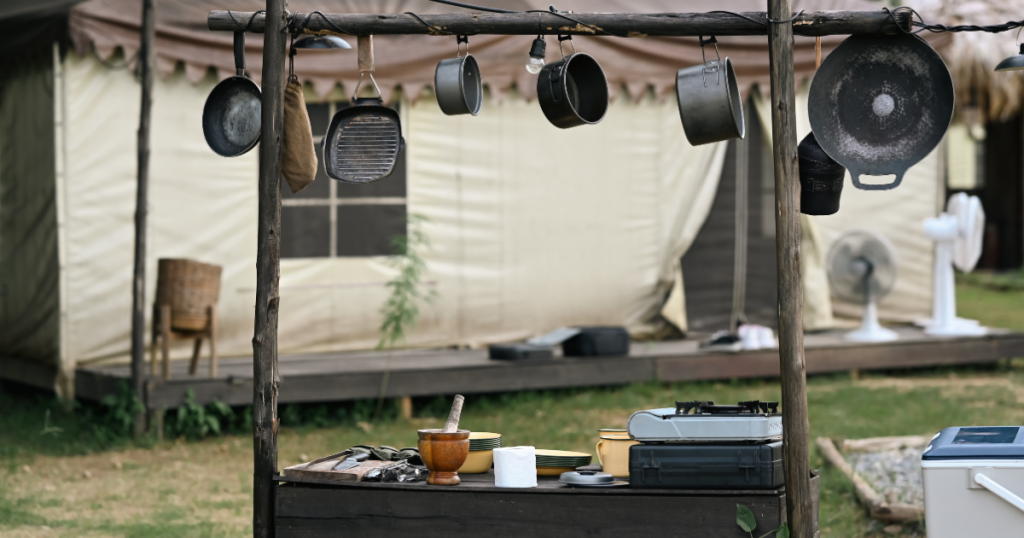
A well-rounded campfire cooking kit starts with the basics—tools and utensils that are essential for preparing and cooking meals. Here’s a list of must-have items:
- Spatula: A sturdy spatula is essential for flipping burgers, pancakes, and other grilled items. Opt for a metal spatula with a long handle to keep your hands safe from the heat.
- Example: The MSR Alpine Utensil Set includes a spoon, spatula, and strainer in one compact package.
- Tongs: Heat-resistant tongs are perfect for turning sausages, vegetables, and other foods on the grill. Choose a pair with a strong grip to prevent slipping.
- Example: The OXO Good Grips 16-Inch Tongs are sturdy, have a good grip, and are long enough to keep your hands safe.
- Knives: A good chef’s knife and a smaller paring knife are indispensable for chopping and slicing ingredients. Consider investing in knives with protective sheaths for safe storage.
- Example: The Morakniv Companion is affordable, durable, and sharp enough for most camp tasks.
- Cutting Board: A portable cutting board provides a clean surface for food preparation. Look for a lightweight, durable option that’s easy to pack.
- Example: The GSI Outdoors Compact Cutting Board is small, ultra lightweight, and perfect for camping.
- Whisk and Mixing Spoon: A whisk is handy for mixing batters or scrambling eggs, while a sturdy spoon is great for stirring stews or sauces.
- Example: This combination whisk and mixing spoon from Oruola is the lightweight and the height of convenience.
- Dutch Oven: A good Dutch oven has been a standby for as long as campers have taken to the woods. It has excellent heat retention and will give a nice even cook.
- Example: The Camp Chef 6-Quart Dutch Oven comes with a lid that doubles as a skillet, giving you more cooking options with less gear.
- Grill Grate: A portable grill grate can be placed over the campfire to cook meats, vegetables, and even toast bread. Choose one that folds for easy storage.
- Example: The Wolf and Grizzly Grill M1 Edition is lightweight, easy to set up, and adjusts to different heights over the fire.
- Cooking Pot and Pan: A cast iron skillet is ideal for campfire cooking due to its durability and excellent heat retention. Pair it with a lightweight, stainless steel pot for boiling water or making soups.
- Example: The Lodge 12-inch Cast Iron Skillet is a classic choice. It’s durable, versatile, and with proper care, it can last a lifetime.
- Cooking Utensils: Don’t forget essentials like a ladle, slotted spoon, and a set of measuring cups and spoons for precise cooking.
- Example: The 5-piece non-stick silicone set from DAILY KISN can be used in your home kitchen, but also makes for a perfect set to take on the go.
- Oven Mitts/Heat-Resistant Gloves: Protect your hands from burns with heat-resistant gloves or oven mitts. These are essential when handling hot cookware.
- Example: The Grill Armor Extreme Heat-Resistant Gloves provide excellent protection and dexterity, making them a smart choice for any camp cook.
- Can Opener: A reliable can opener is a must-have for opening canned goods while camping.
- Example: The Kebly stainless steel can opener has excellent grips for all types of weather, as well as a bonus bottle opener for a very low cost.
- Portable Coffee Maker: Start your morning with a fresh cup of coffee using a portable coffee maker designed for camping.
- Example: The STANLEY 32-oz. French Press is versatile, durable, and BPA-free.
- Roasting Sticks: Essential for marshmallows, hot dogs, and more, roasting sticks are a campfire staple.
- Example: MalloMe’s long-stick skewers are great for the full variety of all of the traditional campfire fare.
- Windproof Lighter: A windproof lighter ensures you can start a fire even in challenging conditions.
- Example: The two-pack of lighters from Laffizz are not only windproof, they are waterproof as well, working in both rain and wind.
Safety Equipment
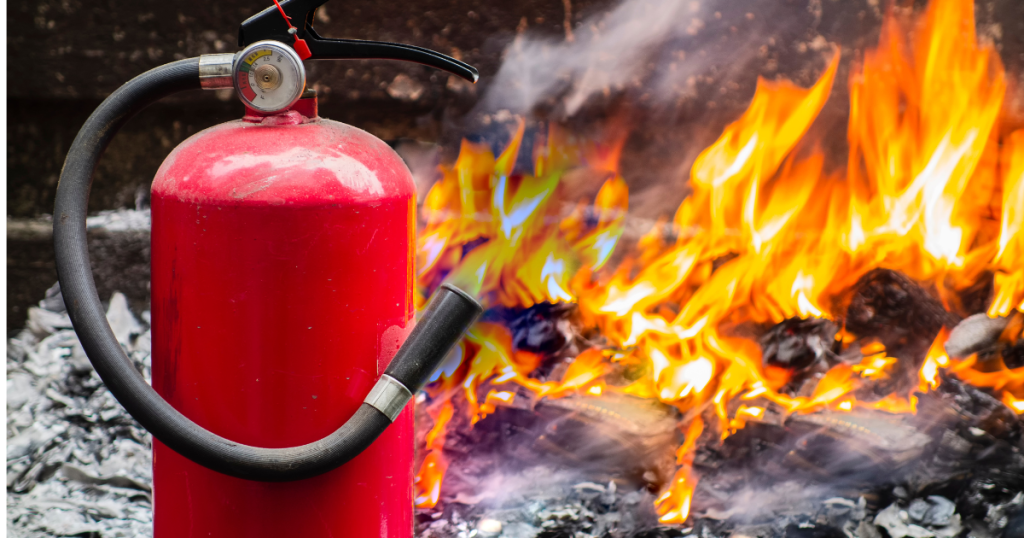
Fire Safety Tools and Gear
Campsite safety always needs be a top priority when cooking over an open fire. Here are essential fire safety tools to include in your campfire cooking kit.
- Fire Extinguisher: A small, portable fire extinguisher can be a lifesaver in case of an emergency. Make sure it’s designed for use on cooking fires.
- Example: A small, portable fire extinguisher like the First Alert portable is easy to pack and provides peace of mind.
- Fire Blanket: A fire blanket can be used to smother small fires or wrap around someone whose clothing has caught fire.
- Example: You shouldn’t have just one, so be sure to pick up a solid 5-pack of fire blankets from JJ Care. They also come with convenient hooks.
- First Aid Kit: Always have a basic first aid kit on hand to treat minor burns, cuts, or other injuries that may occur while cooking.
Food Preparation and Storage
Packing food for campfire cooking requires careful planning to ensure everything stays fresh and is easy to prepare.
Here are some pro tips:
- Pre-Cut and Pre-Portion Ingredients: Save time at the campsite by pre-cutting vegetables, marinating meats, and portioning out ingredients before you leave home. Store them in resealable bags or containers. To prevent cross-contamination, store raw meat in sealed containers or bags and keep it separate from ready-to-eat foods.
- Use Airtight Containers: Keep food fresh and prevent leaks by using airtight containers. These are especially important for liquids like sauces and oils.
- Example: These containers from KUON are not only airtight, they are also collapsible.
- Label Everything: Label containers with their contents and the date they were packed. This makes it easier to find what you need and helps prevent food waste.
- Example: These waterproof labels from ThreeKin also come with a cute woodland animals theme!
- Bring Non-Perishable Foods: In addition to fresh ingredients, pack non-perishable items like canned beans, pasta, and rice. These are easy to prepare and have a long shelf life.
- Use a high-quality cooler with ice packs to keep perishable items like meat, dairy, and fresh produce cold. Consider using a separate cooler for beverages to minimize the number of times the food cooler is opened.
- Example: Coleman’s 316 series is not only a top-of-the-line high-capacity cooler, but it has durable wheels for easy transport to your campsite.
Here are some excellent suggestions from Simon on YouTube covering the variety of situations where proper food packing and storage will keep your food fresh and easy to prepare:
Proper Handling and Storage of Cooking Kit Items
Properly handling and storing your campfire cooking kit items is crucial to prevent accidents and prolong the life of your equipment. Here are some key considerations:
- Store Sharp Tools Safely: Keep knives and other sharp tools in protective sheaths or dedicated storage compartments to prevent accidents.
- Pack Heat-Sensitive Items Separately: Items like lighters, matches, and aerosol cans should be packed away from heat sources to avoid accidental ignition.
- Clean and Dry Cookware Before Storage: Ensure all cookware and utensils are thoroughly cleaned and dried before storing them to prevent rust and contamination.
How to Clean and Maintain Your Campfire Cooking Kit
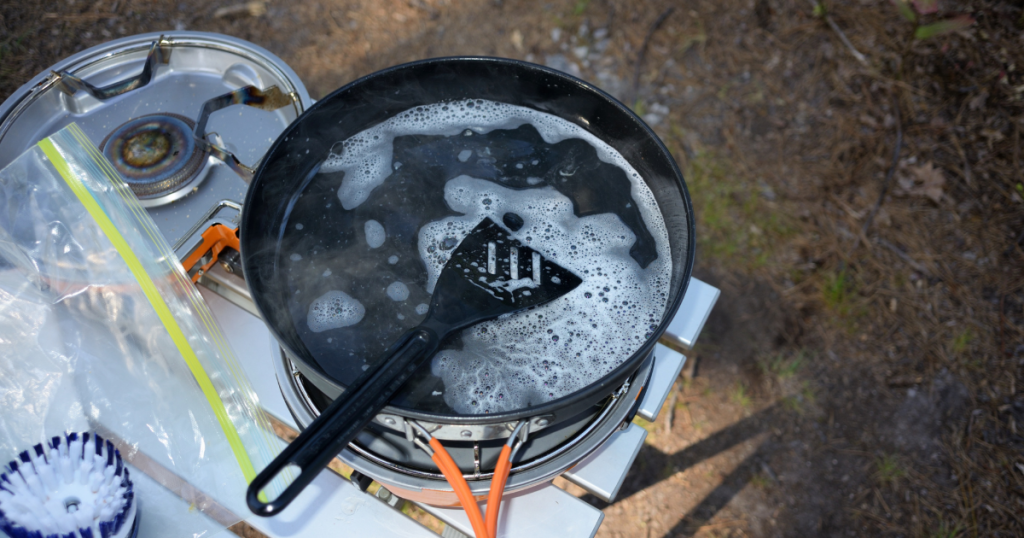
It’s definitely not the most fun and exciting part of camping, but keeping your campfire cooking kit clean and well-maintained is essential for ensuring its longevity and performance.
Here is a five-step process to ensure safe and effective cleaning:
- Clean Immediately After Use: The best time to clean your cookware is right after use. This prevents food from hardening and makes cleaning easier. A small scrub brush is perfect for cleaning stubborn food residue from pots and pans.
- Use Biodegradable Soap: When washing dishes in the wilderness, use biodegradable soap to minimize environmental impact. Wash dishes at least 200 feet away from water sources to avoid contamination.
- Season Cast Iron Cookware: Cast iron cookware requires regular seasoning to maintain its non-stick surface. After cleaning, dry the skillet thoroughly and apply a thin layer of vegetable oil before storing.
- Dry Everything Completely: Before packing away your cooking kit, ensure all items are completely dry to prevent rust and mold. Bring along a few dish towels for drying cookware and wiping down surfaces.
- Storage Bags: Use storage bags to keep cleaning supplies organized and separate from food and cooking tools.
Additional Gear for Comfort and Convenience
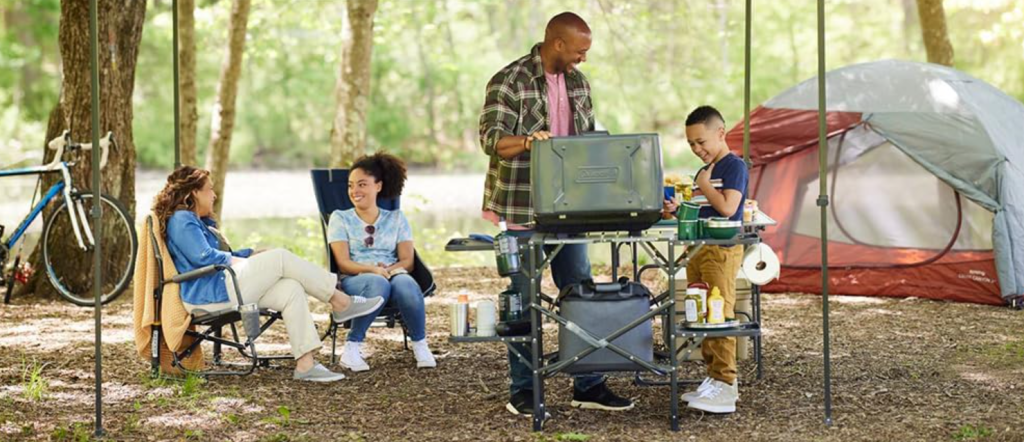
Optional but Useful Items to Include
While the basics are essential, there are a few additional items that can make your campfire cooking experience even more enjoyable:
- Portable Cook Station: A portable camping table is fine, but a full station provides additional surface area and storage for organizing food preparation.
- Example: This full cook station from GCI Outdoor shown above is slim and portable with a sizeable amount of space and functionality.
- Collapsible Sink: A collapsible sink makes washing dishes on-site in the wild much easier. Simply fill it with water and use it as a portable basin.
- Example: This two-pack of foldable sinks from Tiawudi is BPA-free and is great for dishes or hands, ice bucket for drinks, storage container and more.
- Camping Chairs: Comfortable chairs are a must for relaxing around the campfire while your meal cooks.
- Example: The Kelsyus canopy chair is great for the campfire, but also comes with a carrying bag and retractable sun shade to take on the go!
Best Ways to Transport Your Kit to the Campsite
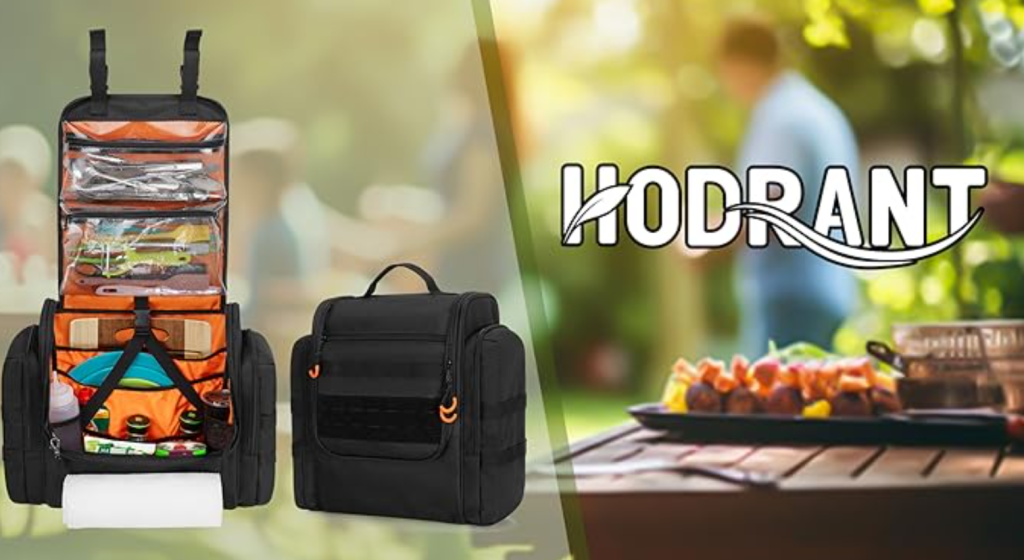
Transporting your campfire cooking kit safely is just as important as packing it efficiently. Your stove and larger items likely come with their own transport cases, but here are some additional tips for managing your smaller gear:
- Use a Durable Backpack or Carrying Case: A sturdy backpack or carrying case like the one shown above with multiple compartments is ideal for transporting your cooking kit. Look for one with padded straps for added comfort.
- Secure Items with Straps or Bungee Cords: Use straps or bungee cords to secure larger items and prevent them from moving around during transport.
- Consider a Rolling Cooler: As mentioned earlier, if you have a lot of gear, a rolling cooler can be a convenient way to transport your cooking kit and food items.
Assembling the ultimate campfire cooking kit takes some thought and preparation, but the effort is well worth it. With the right tools, cookware, and safety equipment, you can enjoy delicious meals cooked over an open fire, making your camping experience even more memorable.
Remember to customize your kit based on your specific needs and preferences, and don’t be afraid to add a few extra items that enhance your comfort and convenience. Happy camping and happy cooking!
Save Your Ultimate Campfire Cooking Kit Checklist
To help you get started and stay organized, we’ve created a handy checklist you can download and print. This checklist includes all the essential items discussed in this article. This will serve as a convenient guide to ensure you don’t forget any important items when assembling your campfire cooking kit. Keep it with your camping gear, and use it each time you prepare for a new adventure!
Right-click to save or print
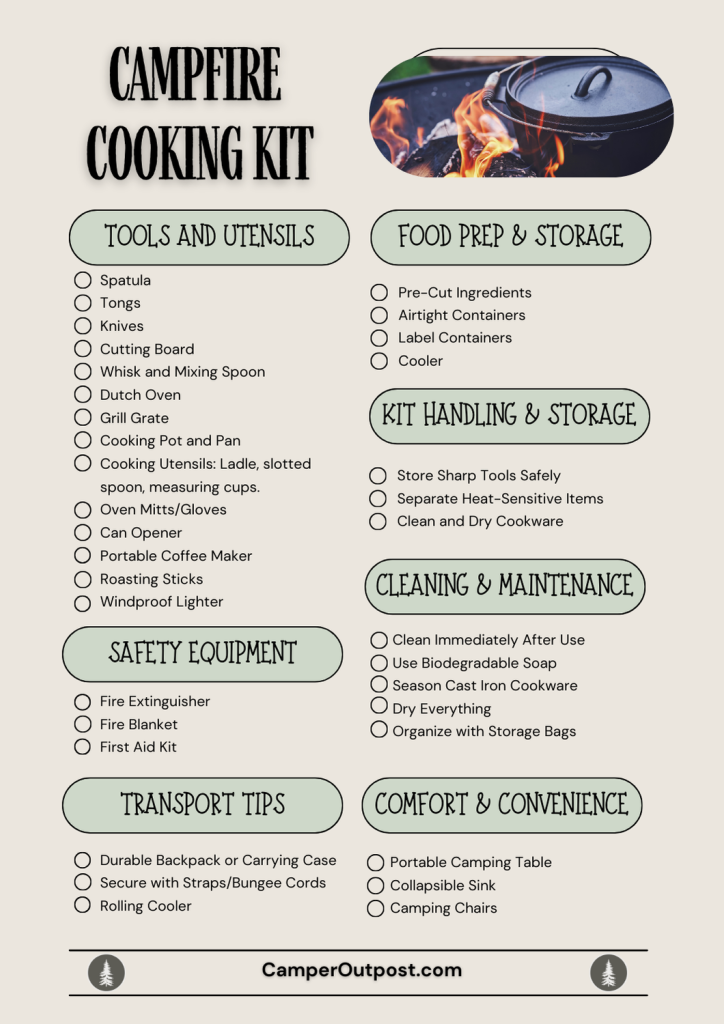
See Our Latest Posts
- 21 Fun Camping Games to Entertain Yourself Outdoors
- How to Set Up a Hammock for Camping
- Compact Camping Gear That Saves Space in Your RV or Van
- Top 15 Most Beautiful Waterfalls In The World To Visit In Your Lifetime
- Top 12 Camping Gadgets and Accessories You Didn’t Know You Needed (2025)
Write A Guest Post For Us!
Are you passionate about camping and the great outdoors?
We’re excited to announce that we’re accepting guest posts
in the camping and outdoor niche!

